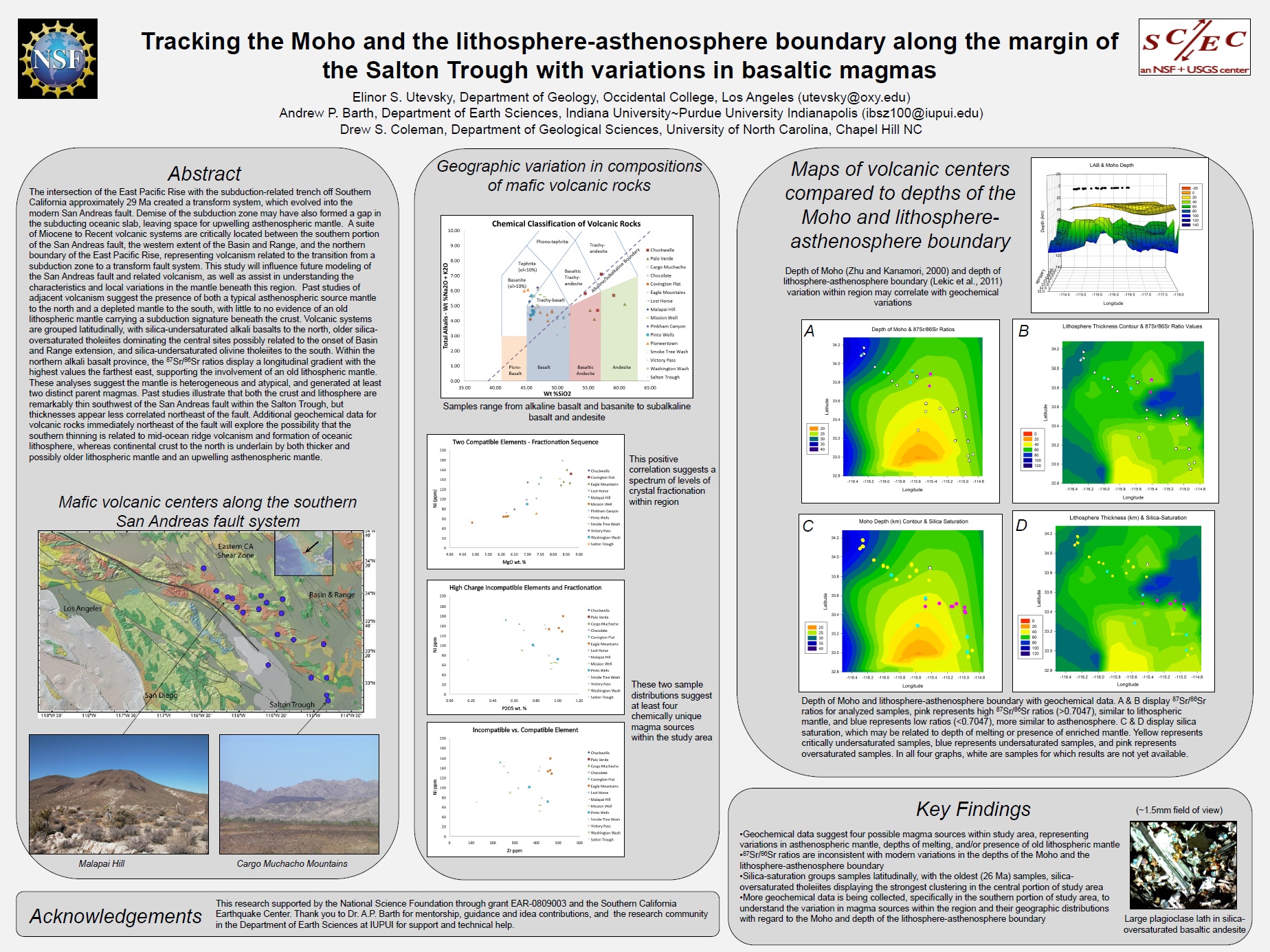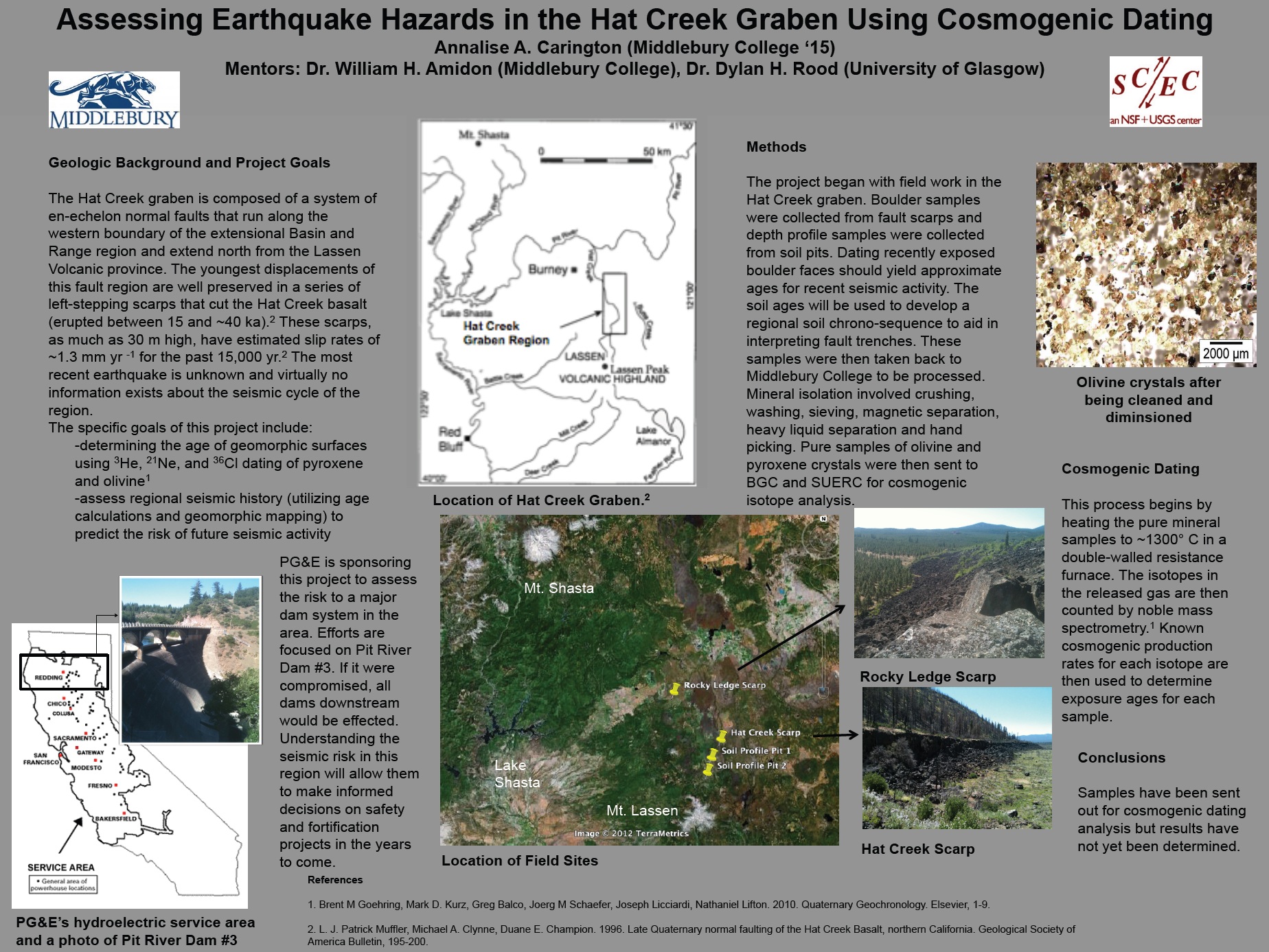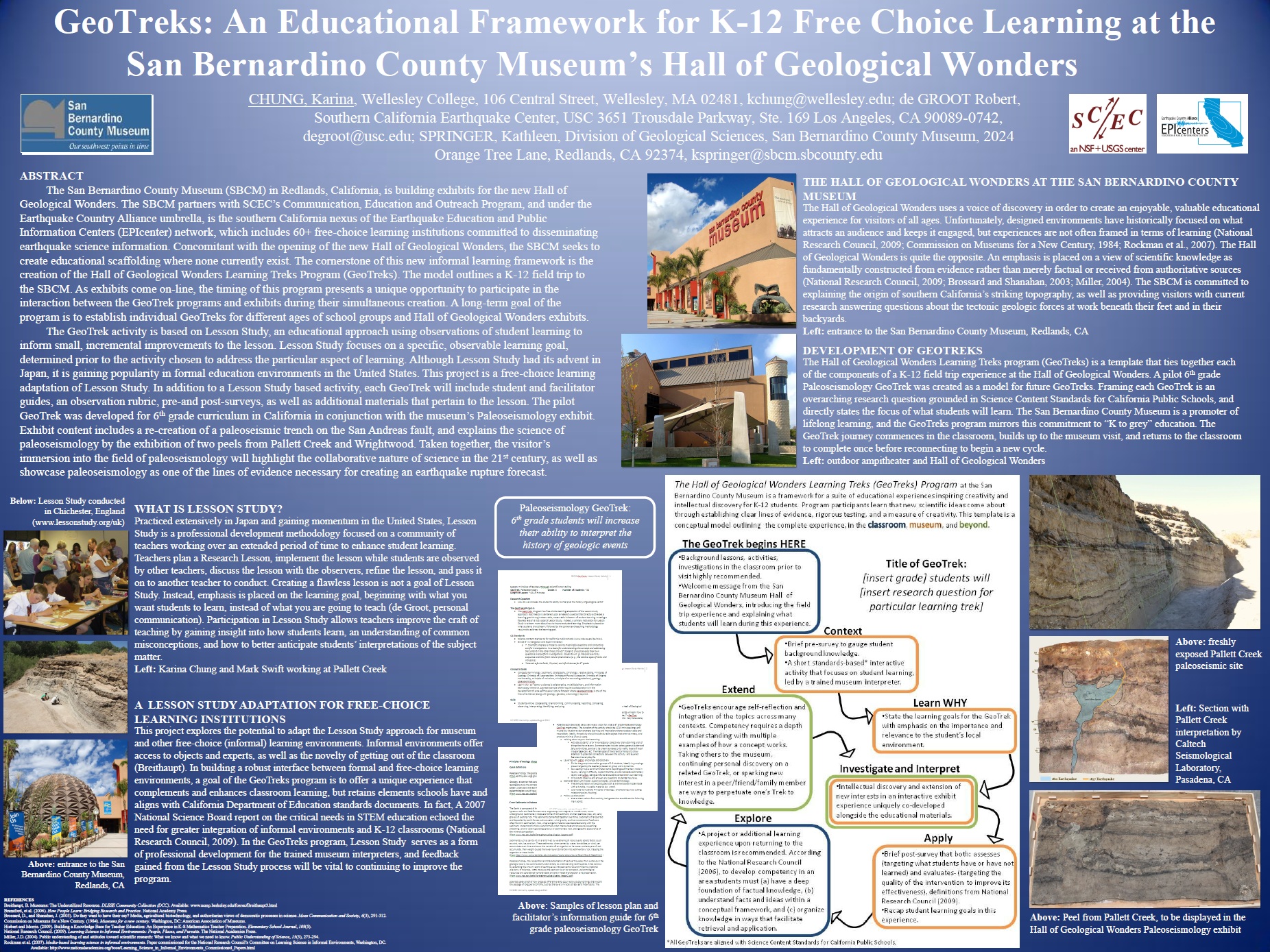| 2012 Research Projects |
|
Tracking the Moho and the Lithosphere-Asthenosphere Boundary Along the Margin of the Salton Trough
|
Project Description: Improving models of crustal and upper mantle structure is necessary for understanding crustal architecture and how rifting processes influenced the development of lithospheric structure in southern California. The summer intern will use the petrology of basalts and mantle xenoliths from the southwestern Basin and Range and Salton Trough region to explore geophysical models of crust and lithosphere thickness and composition. The project will begin with field sampling in selected areas of the southwestern Basin and Range province in southern California. Following fieldwork, the intern will be responsible for carrying out petrography and laboratory measurements of rock and mineral compositions. The summer intern should have a background in petrology and/or geochemistry. This project will contribute to the SCEC Unified Structural Representation project in the development of a 3D model of Earth structure in southern California.
Intern(s): Elinor Utevsky
Mentor(s):
Andrew Barth, Indiana University
Sarah Douglas, Graduate student
|
 |
|
Paleoseismology and Tectonic Geodesy of the San Jacinto and San Andreas Faults Near San Bernardino, California
|
Project Description: The San Andreas and San Jacinto faults together accommodate about half of the relative motion between the Pacific and North American Plates in southern California. I am looking for two interns to help with a paleoseismic study of the San Jacinto fault and with collection of GPS data to monitor strain accumulation across both faults. In the early part of the summer we will work in a paleoseismic trench across the San Jacinto fault near Moreno Valley/Hemet California. The goal of this work is to identify and document stratigraphic evidence for prehistoric earthquakes on the San Jacinto fault. The GPS data collection will begin after the trenching is finished. A large-scale GPS data collection campaign, involving numerous students and local high school teachers will take place from July 22 to August 9. This will involve several days of training and orientation in using the GPS equipment, followed by 5 days of field work, traveling to various benchmarks and setting up GPS equipment. Some sites will requiring hiking 2 miles or more each way and some will require camping. Interns should be in good physical condition and should enjoy physical exertion and working outside. They should be willing to carry equipment and to work in conditions that may be hot, windy, muddy, etc.
Intern(s): Rainer Luptowitz, Joseph Berg
Mentor(s):
Sally McGill, California State University, San Bernardino
Thomas Crane, Graduate student
|

 |
|
Preparing Models for Scenario Earthquake-Shaking Computations for Southern California, Las Vegas, and Lake Tahoe
|
Project Description: This project is running hundreds of earthquake scenarios for areas of California and Nevada, to create urban hazard maps based on physics and geology:
- Set-up and run earthquake scenarios for Lake Tahoe and Las Vegas, as well as Olsen’s (2000) LA Basin scenarios, with stochastic geotechnical layers and basin floors. The intern will use interactive and tutorial tools to set up models for intensive seismic-wave computations on small Linux clusters, as well as laptops. The intern will develop an understanding of the geological, geophysical, and geotechnical data available on faults and basins in these regions.
- Use SCEC’s Broadband Platform to compare predicted earthquake shaking against data recorded from small earthquakes.
- Combine shaking maps computed for all scenarios in the Las Vegas and Lake Tahoe regions into probabilistic hazard maps. The intern will develop an understanding of how various geological, geophysical, and geotechnical factors affect earthquake shaking.
- Presentation of results at SCEC workshops and the SCEC Annual Meeting (with Intern presentations), and journal publication authorship opportunities.
Intern(s): Kelley Hall
Mentor(s):
John Louie, University of Nevada, Reno
Gretchen Schmauder, Graduate student
Annie Kell-Hills, Graduate student
|
 |
|
The Rheology of Granular Flows
Project Description: Granular flows are ubiquitous and poorly understood. How much stress does it require to make a landslide flow? How fast will the powdered rock inside a fault zone move during an earthquake? These are open questions that hinge on determining the rheology of granular flows. The UC Santa Cruz lab is performing experiments using a state-of-the-art rheometer on samples ranging from beach sand to finely ground rock powder. We are looking for 1-2 laboratory assistants to help with these experiments in the summer of 2012.
Intern(s): Kevin Bernardo
Mentor(s):
Emily Brodsky, University of California, Santa Cruz
Thibault Candela, University of California, Santa Cruz
|
 |
|
Information Technology Support for the SCEC Borehole Instrumentation Program
|
Project Description: The SCEC borehole instrumentation program is a data-gathering effort that coordinates seismic observations from borehole instruments in southern California. This project will employ 1 undergraduate researcher to assist with the ongoing development of a web-based waveform explorer to provide search and waveform viewing capabilities of earthquakes recorded at the borehole sites. The student will be assisting in the website development that integrates the waveform explorer into a site dedicated to the SCEC borehole instrumentation. Depending on level of expertise, web programming skills and low-level data-processing that will require attention to the details of the data storage format and code development in C may also be part of the project.
Intern(s): Matthew Cook
Mentor(s):
Jamison Steidl, University of California, Santa Barbara
Sandra Seale, University of California, Santa Barbara
Paul Hegarty, University of California, Santa Barbara
Robin Gee, Global Earthquake Model Foundation
Francesco Civilini, University of California, Santa Barbara
|
 |
|
Seismic Anisotropy Produced by the Pelona-Orocopia-Rand Schists: Calibration Using the SCSN Network Surrounding the Orocopia Mountains
Project Description: The Pelona-Orocopia-Rand schists are postulated to underlie much of the Southern California Mojave tectonic block. Tectonic models for the evolution of Southern California vary depending on the lateral extent of this schist terrane. While these schists are exposed along the San Andreas plate boundary fault, there is no direct evidence of their breadth into and under the Mojave. Studies using seismology may provide the best opportunities to detect the schists in place at depth. These schists have strong rock fabrics that can impart observable seismic anisotropy to seismic waves. The presence of this crustal seismic anisotropy and the inferred subsurface distribution of schists can influence studies within SCEC Focus Areas (Unified Structural Representation, Lithospheric Architecture and Dynamics) and Disciplinary Activities (seismology). This summer project is a multi-disciplinary calibration study designed to use real seismic waves in order to quantify how much they can be affected by the Pelona-Orocopia-Rand schists. The Orocopia Mountains near Palm Springs is filled with Orocopia schist, making it the schist's type locality. The Southern California Seismic Network (SCSN) has seismic stations that surround the Orocopia Mountains that record numerous earthquakes associated with the Salton Trough and San Andreas fault. The goal of this project is to examine seismic waves before they enter and after traveling through the mountain range in order to measure how much alteration occurred caused by the schists. The intern will extract earthquake seismic data from the SCSN and carry out seismic anisotropy analyses. The intern will integrate these seismological results with existing structural geology, rock fabric deformation, and lab petrophysical studies. During the internship we will make trips to see the schists in outcrop. The intern will gain experience in seismic data analysis, digital signal processing, advanced Linux and research computer applications. Opportunities exist to present at the SCEC annual meeting, GSA or AGU national meeting, and for journal publication authorship.
Intern(s): Ding Zhang
Mentor(s):
David Okaya, University of Southern California
|
|
|
Assessing Earthquake Hazards in the Hat Creek Graben Using Cosmogenic Dating
|
Project Description: This project will use cosmogenic surface exposure dating of landforms and lava flows to better understand the earthquake history and hazards of faults within the Hat Creek graben, northern Sierra Nevada, California. The graben consists of a system of en echelon normal faults extending north from the Lassen Volcanic province, which have likely produced large magnitude (Mw > 6) earthquakes during the Holocene (last 12,000 years). Developing a paleoseismic record in this region is important for hazard analysis and assessment of safety for existing infrastructure (i.e., hydroelectric dams, gas pipelines, and aqueducts). The intern will participate in an ongoing research project that involves detailed geomorphic mapping, paleoseismic trenching, and geochronology. The specific goal of this internship is to determine the age of geomorphic features (e.g., glacial deposits, river terraces, fault scarps, and lava flows) using 3He, 21Ne, and 36Cl dating of volcanic minerals, including pyroxene, olivine and feldspar. This will involve field mapping and cosmogenic sampling early in the summer, followed by preparation of samples for cosmogenic dating and participation in laboratory analysis.
Intern(s): Annalise Carington
Mentor(s):
William Amidon, Middlebury College
Dylan Rood, University of Glasgow
|
 |
|
Creating Earthquake Science Exhibits in the Hall of Geological Wonders
|
Project Description: The San Bernardino County Museum(SBCM) is completing a suite of exhibits in our new Hall of Geological Wonders. The SBCM is a free choice learning environment and part of the EPIcenter (Earthquake Education and Public Information Center) network in California, providing earthquake awareness and preparedness messaging. Many of the new exhibits are focused on earthquake science, utilizing place-based learning to teach big ideas in geosciences. One of these exhibits will interpret paleoseismology, which will include a three-dimensional recreation of a paleoseismic trench on the San Andreas fault, with the addition of two actual peels from the San Andreas Fault - one from Pallet Creek, the other from Wrightwood. Our intern will assist in creating exhibit content as well as the activity that will complement the exhibit (a hands-on interactive inside the re-created trench), as well as educational materials for school groups. Additionally, we will produce an interpretive field guide for Pallett Creek that will provide our visitors and other EPIcenters with a companion interpretive piece.
Intern(s): Tara Redinger, Karina Chung
Mentor(s):
Kathleen Springer, San Bernardino County Museum
|

 |
|
University ShakeOut 2012 Planning and Evaluation
|
Project Description: Intern will assist in current disaster preparedness public education, warning, and social media planning, evaluation, and training activities. Tasks may include: 1) Help organize an electronic (Endnote) annotated bibliography of disaster preparedness scientific literature, 2) Help map trends in earthquake drill responses over time (SPSS, Excel), 3) Assist in formatting a campus-specific ShakeOut drill survey for CSU Fullerton faculty and students using web-based survey software (e.g., Survey Monkey), and 4) Help analyze and summarize evaluation data in preparation for publication.
Intern(s): Erica Garland
Mentor(s):
Michele Wood, California State University, Fullerton
|
 |
|
Paleoseismology of the San Andreas Fault in the Carrizo Plain
|
Project Description: The San Andreas fault in the Carrizo Plain has been a target of our paleoseismology research for more than 20 years. This year, we plan to excavate the fault at Wallace Creek in the Carrizo National Monument, and nearby sites, to expose Holocene ruptures and collect samples for radiocarbon dating. The results will be used to better constrain the slip rate and slip history of this important fault. We seek an intern to help with field work and office work. The office work involves drafting trench logs and organizing samples, logs, and other data.
Intern(s): Terry Cheiffetz
Mentor(s):
Lisa Grant Ludwig, University of California, Irvine
Sinan Akciz, University of California, Los Angeles
J Ramon Arrowsmith, Arizona State University
|
|
|
(no name)
|
Project Description:
Intern(s): Natalia De Vries
Mentor(s):
Josh West, University of Southern California
|
|
|
Establish the Rate of Sediment Accumulation in Zippingpu Reservoir, Sichuan, China, to Assess the Rate of Recent Erosion From the Drainage Basin
|
Project Description:
Intern(s): Zichen Xiao
Mentor(s):
Doug Hammond, University of Southern California
|
|
|
Promoting Citizen Science with the Quake-Catcher Network: Seismology Online Content-Based Design for Use by Museums and Libraries
|
Project Description:
Intern(s): Michelle Vanegas
Mentor(s):
Robert de Groot, University of Southern California
|
|














